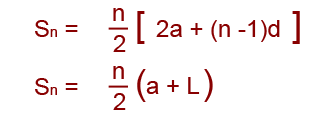Sequences and series notes
Below are some sequences and series notes. They should help when working with sequences and series.
- A series of numbers following a set rule is called a sequence.

…is an example of a sequence - Each number in a sequence is called a term.
- The nth term of a sequence is sometimes called the general term.
- A sequence can be expressed as a formula for the nth term, for example;

…produces the sequence;

…by replacing n with 1,2,3,4 etc in 4n + 1. - A sequence can be expressed by a recurrence relationship for example the same sequence 5,9,12,17,… can be formed from;

…in all cases U must be given. - A recurrence relationship of the form;

…is called an arithmetic sequence. - All arithmetic sequences can be put in the form.

- The nth term of an arithmetic series is a + (n-1)d, where a is the first term and d is the common difference.
- The formula for the sum of an arithmetic series is;

…where a is the first term, d is the common difference, n is the number of terms and L is the last term in the series. - You can use ∑ to signify ‘sum of’. You can use ∑ to write series in a more concise way, for example;

